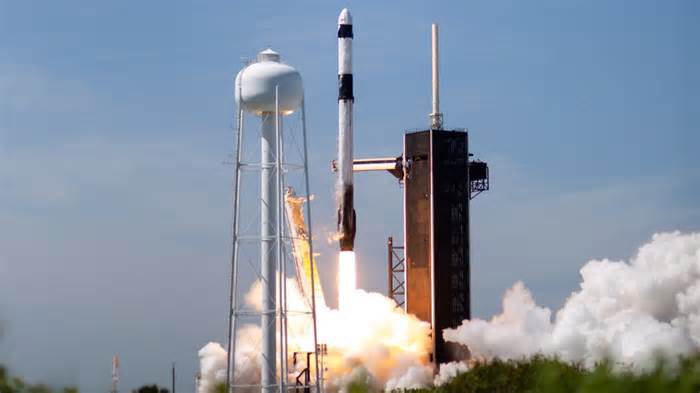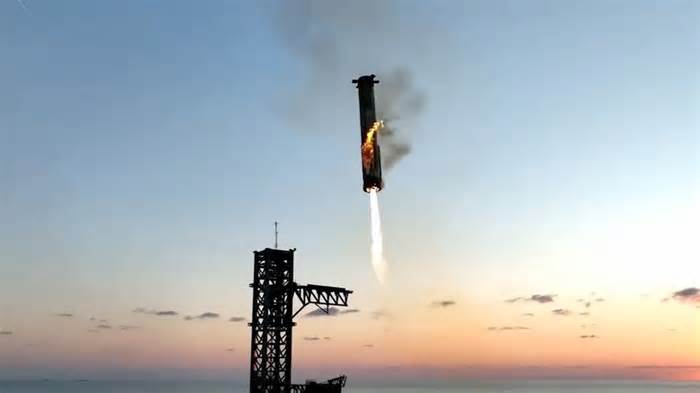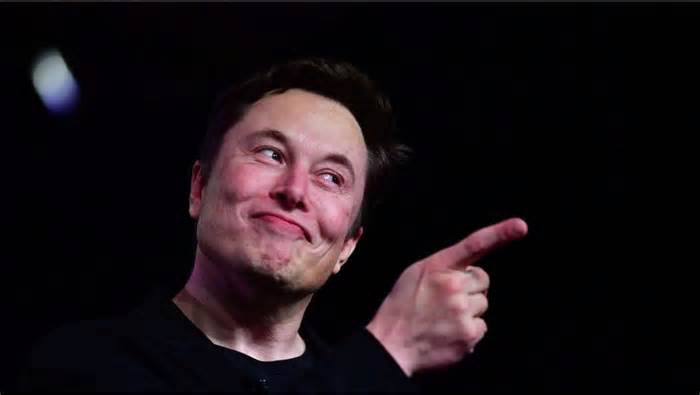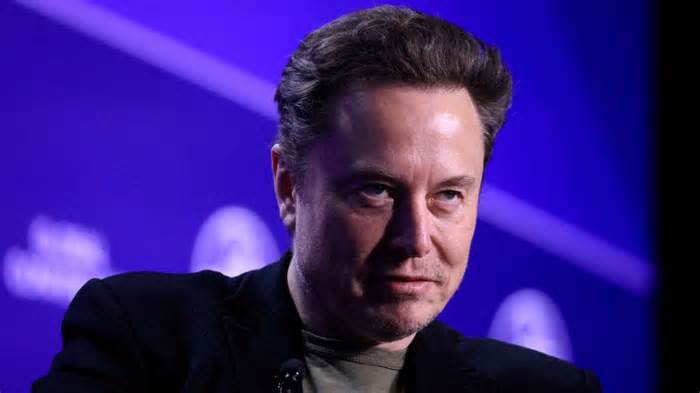
After years of missed deadlines, Tesla enters the robotaxi race
- by Marketplace
- Oct 15, 2024
- 0 Comments
- 0 Likes Flag 0 Of 5

Courtesy Tesla
CEO Elon Musk has been promising fully autonomous cars since 2016. The Cybercab might be too late, says The Verge’s Andrew Hawkins.
get the podcast * Subscribe
The last week has been a big one for companies owned by Elon Musk. On Sunday, SpaceX made history by successfully launching its powerful Starship rocket and then landing the Super Heavy booster back on the launch pad.
And Thursday, after years of hype, Tesla finally debuted its robotaxi, or in Tesla speak, the Cybercab.
Musk has been making and breaking promises about Tesla’s autonomous vehicle for years. So, did the debut of the Cybercab finally deliver?
Andrew Hawkins is the transportation editor for The Verge, and he’s been writing about Tesla’s autonomous vehicle ambitions for years.
Marketplace’s Meghan McCarty Carino spoke to Hawkins about what the Cybercab unveiling means for Musk and for Tesla.
The following is an edited transcript of their conversation.
Andrew Hawkins: It’s a small sedan that looked sort of like a truncated Model 3. It has just enough room for two passengers inside. The doors were what’s called butterfly-wing doors — they kind of open like a Lamborghini’s doors would, they open up and away from the vehicle — and it had no steering wheel, no pedals, no gear shift, none of the traditional controls that we would normally associate with a car. And that’s because it’s designed to be a fully autonomous, what we call purpose-built driverless vehicle.
Meghan McCarty Carino: As you noted in your piece, this debut has been promised for quite some time. Can you talk us through the timeline of this product from when it was first teased to now?
Hawkins: So, I’ve been covering Tesla for a very long time, and almost as long as I’ve been covering it, and certainly about as long as he’s been the CEO of the company, Elon Musk has been promising some aspect of self-driving technology capabilities. In 2016 he said that self-driving Tesla vehicles were just two years away. The following year, he said that it would actually just be six months. And then in 2018, he said it was still a year away, but that it would be 200% safer than human driving. And then in 2019, he said there would be a feature-complete self-driving car this year. Well, it was not until 2024 that that actual vehicle arrived, and I think it’s really important to note that this is still not a real vehicle. It’s just a prototype, what Tesla showed off at this event. And he said at the event that it would go into production, lo and behold, in two years. So, it’s this thing that he does, and has been doing for a very long time, where the technology is sort of perpetually two years away from arriving.
McCarty Carino: When Musk first started making these promises about autonomous vehicles back in 2016, he kind of seemed to be on the cutting edge of this, but eight years later, now, in 2024, there are other autonomous vehicles already on the road from companies like Waymo and Cruise. Is Tesla just arriving too late?
Hawkins: Yeah, I would argue that they’re a bit behind the ball here. While he has made some progress and has been sort of at the forefront of in advocating and evangelizing for this technology, he has been sort of outpaced by a lot of the other players in the field. So, you mentioned Waymo. They’re owned by Alphabet, which is the parent company of Google, and today they have over 600 fully driverless vehicles operating in San Francisco, Los Angeles and Phoenix, where any person can download the app on their phone and hail one today as they would an Uber, and a car with no one in the front seat will show up and take you to where you want to go. Now, these vehicles operate in what’s called a geofenced area, that’s a very limited geographic area. And what Tesla and Elon Musk are saying is “We don’t need those limitations, we should be able to drive wherever we want, whenever we want.” And not only that, but also, you should be able to own your own self-driving car, whereas all these other companies are pitching a fleet-owned vision of what this technology looks like. So, there are a lot of differences, and I think that that’s sort of where he’s been running into some of these obstacles.
McCarty Carino: Are there any other sort of technological differences between what Tesla is putting forward and these other vehicles on the market already?
Hawkins: Yeah. So, the main one is sort of the sensor suite that Tesla uses. Notably, the company does not use LIDAR, which is a laser-powered sensor that you will find on pretty much every other autonomous vehicle in the world, including in the U.S. and China and elsewhere, because this is a sensor that serves as what’s called a redundant system. It helps back up the other sensors that already exist on the vehicle. And what Musk says is LIDAR is too expensive. It doesn’t really allow us to produce these vehicles at scale. And not only that, but it also won’t allow us to sell them to normal people, and therefore we have to rely exclusively on cameras. And so that’s been sort of Tesla’s approach to this point, which is a vision-only system, and also, obviously, a lot of artificial intelligence as a way to sort of help explain the world to the vehicle. But that major difference, those lack of redundant sensors, is something that I think a lot of experts have noted. It could be a serious problem for Tesla if they continue along the same path.
McCarty Carino: So, there was a surprise second vehicle that was also debuted on Thursday. This was an autonomous bus called the Robovan. It almost looked like a light- rail vehicle or something. What did you make of this?
A rendering of the art deco-looking Robovan alongside a Cybercab. (Courtesy Tesla)
Hawkins: Yeah, it had a very appealing art deco kind of style to it that I think a lot of people would probably say looks kind of cool. I think there was a missed opportunity. I don’t understand why it’s not called the Cybervan, why they went with Robovan instead, but, you know, there’s my opinion. I don’t think that this thing is ever actually going to end up in production or ship for a couple reasons. One, Musk is very adept at sort of pulling surprises out of his hat or from up his sleeve. And so, this was one of those “one more thing” moments that Steve Jobs and Apple were sort of famous for doing. But that said, this is a guy who, for years and years and years has been railing against public transportation, saying that it’s atrocious and we shouldn’t have to sit next to strangers. And now suddenly he has a high-capacity 20-person bus or van that’s available? I’m a little bit skeptical that that’s going to be a reality. But that said, it was art deco, so it looked cool.
McCarty Carino: Well, you point out that this launch is coming at a vulnerable time for Tesla and Musk himself. Can you expound on that a bit more?
Hawkins: Yeah. So, Tesla’s primary business is making and selling electric cars. They’ve been very good at doing that for a number of years now. They’re one of the most successful companies in the automotive space in the last several decades, I would argue. But that said, you know, things are kind of a little bit dicey in the world of EVs these days, sales have kind of slowed down. They’re not growing as fast as they were several years ago. And Tesla’s own sales have reflected that. They had several quarters in which their sales were consecutively down and also down year over year. Things have picked up slightly over the last quarter, but I think it’s still the case that this kind of more of a depressed market is affecting the company in a big way and could continue to affect them. And obviously Musk has come out very vocally in support of former President Donald Trump’s reelection and Trump has said that he wants to roll back a lot of the incentives that President Joe Biden has passed to help grow the electric vehicle sector. So, there’s a lot of confusing signals that are being sent around. But at this stage, I think he really needed something to help prop the stock up a little bit, because the stock has been down, and it’s not clear in the immediate aftermath of this event that that’s actually going to work.
More on this
As Andrew mentioned, the “We, Robot” event, as Tesla branded it, was not just about the Cybercab. We also got a glimpse of the Robovan and a fleet of humanoid robots named Optimus, which mingled with the crowd, danced and tended bar.
Playing charades with the Tesla Optimus robot last night. This is either the single greatest robotics and LLM demo the world has ever seen, or it's MOSTLY remote operated by a human. No in between. pic.twitter.com/vCqzk8DDdO
Please first to comment
Related Post
Stay Connected
Tweets by elonmuskTo get the latest tweets please make sure you are logged in on X on this browser.
Sponsored
Popular Post
Tesla: Buy This Dip, Energy Growth And Margin Recovery Are Vastly Underappreciated
28 ViewsJul 29 ,2024






 Energy
Energy



















